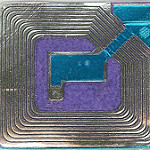Imagine a bustling morning getting ready for work: you grab your briefcase, jacket, and…that’s it! Your car keys or bus pass have been replaced by a tiny microchip embedded in a card or band. You stop to get a coffee and pay with your chip, you scan in at your office to gain entrance, and you may even use your chip to perform parts of your job. Though this scenario might not be common today, this technology exists and has the chance to transform a multitude of fields. While some arts institutions have already been using this Radio Frequency Identification technology for inventory purposes, opportunities are emerging for diverse new uses. Let’s start at the beginning.
What is RFID?
Radio Frequency Identification (RFID) is a technology that uses radio waves to transmit information in order to identify people or objects. An RFID tag is made of a microchip attached to an antenna which communicates information to a reader that, in turn, converts the information into digital data to be translated by a computer.
Sounds like a lot of steps? Here’s how the process works: an RFID reader sends out electromagnetic waves that an RFID tag’s antenna is calibrated to receive. These waves power the circuits in the tag, enabling it to operate. Then, the tag modulates the electromagnetic waves that it receives and reflects the changed waves back to the reader. The reader then acts as a converter to decipher this data.
RFID vs. Barcodes
RFID technology is often seen as a replacement for barcodes. While there will still almost certainly be a use for barcodes in some industries, there are many advantages to using RFID as an alternative. Each RFID tag (which may be attached to any object) has a unique identification code that contains information specific to that tag. Think about the barcode on your pomegranate Greek yogurt – that barcode is the same one on all the pomegranate Greek yogurts made by that manufacturer, but without a unique identifier you won’t know which one will expire first. The other advantage is that RFID readers function without tags needing to be visible. A barcode reader needs a clear path to a barcode in order to read it, which takes more time to scan. Barcodes also must be placed on the outside of items, increasing wear and tear. An RFID tag can be read from different distances quickly and can be enclosed in plastic making it durable.
Paying with RFID is faster and more secure
RFID has many attractive uses in commerce. In fact, the speed of an RFID transaction is about 10 seconds faster than a credit card purchase and about twice as fast as a cash transaction. These transactions are highly encrypted and the type of data being transmitted is not sensitive information like account numbers, but rather transaction numbers. This makes the transactions secure. Additionally, vendors don’t need internet access to complete RFID purchases, as opposed to credit card machines, making sales possible all of the time.
Why should arts organizations embrace this technology?
Many museums are already using RFID technology for inventory and security of their pieces. If organizations already have the technology, there are boundless opportunities as to how they can use it to increase efficiency and enhance the visitor’s experience. Do you have any ideas about how you would use RFID at your institution? Let us know in the comments.
Banner image by midnightcomm, licensed under Creative Commons.


